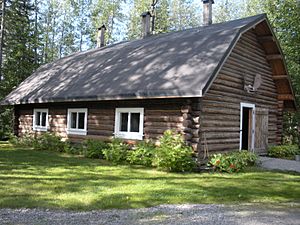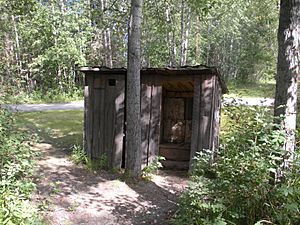Rika's Landing Roadhouse facts for kids
|
Rika's Landing Roadhouse
|
|
|
U.S. Historic district
Contributing property |
|
 |
|
| Location | Mile 274.5, Richardson Highway, Big Delta, Alaska |
|---|---|
| Area | 2.3 acres (0.93 ha) |
| Built | 1909 |
| Architectural style | Multistory Log and clapboard, tarpaper roof with dormers |
| Part of | Big Delta Historic District (ID91000252) |
| NRHP reference No. | 76000364 |
Quick facts for kids Significant dates |
|
| Added to NRHP | September 1, 1976 |
| Designated CP | March 20, 1991 |
Rika's Landing Roadhouse is a historic building in Big Delta, Alaska. It was once a busy stop for travelers in the Alaskan wilderness. A "roadhouse" was like a hotel and restaurant combined. It offered food, a place to sleep, and supplies for people traveling long distances.
This roadhouse is famous because of Rika Wallen, who owned and ran it for many years. It was a very important place in the Alaska Interior. Over time, new roads and bridges were built, and fewer people passed by the roadhouse. Today, Rika's Landing Roadhouse is part of the Big Delta State Historical Park. It helps us remember what life was like in early Alaska. The roadhouse was added to the National Register of Historic Places in 1976.
Contents
The Richardson Highway: Alaska's First Major Road
The Richardson Highway was a super important route in Alaska. It helped people travel and settle in the region. This highway started as a simple trail in 1898. It connected the port of Valdez to Eagle on the Yukon River. The U.S. Army built it during the Klondike gold rush. They wanted an "all-American" way to reach the gold fields.
After the gold rush, the Army kept the trail open. It connected their forts at Fort Liscum and Fort Egbert. This trail became a main route to the Alaska Interior during the Fairbanks Gold Rush in 1902. A telegraph line was also built along the trail in 1903. This allowed people to send messages across long distances.
Roadhouses: Rest Stops for Travelers
Many roadhouses were built along this trail. There were about 37 of them! These places were like rest stops for travelers. They offered meals, beds, and supplies. Roadhouses were usually placed about 15 to 20 miles apart. This made it easy for people to stop and rest during their long journeys.
Early Days at Bates Landing
The Tanana River was a big obstacle for travelers on the Valdez-Eagle trail. A ferry was set up to help people cross the river. This spot was first called Bates Landing. It was near where the Tanana River meets the Delta River. The government collected a small fee from travelers using the ferry.
In 1907, a place called McCarty Station was built. It helped maintain the WAMCATS telegraph line that crossed the Tanana River. Several log cabins served as the telegraph office and living quarters for workers.
The First Trading Post
In 1904, a prospector named Ben Bennett built a trading post at Bates Landing. He sold it to Daniel G. McCarty in 1905. The trading post soon became a roadhouse and was known as McCarty's. Another prospector, Alonzo Maxey, built a competing roadhouse. By 1907, Maxey had taken over McCarty's.
John Hajdukovich's Vision
Around 1906, an entrepreneur named Jovo 'John' Hajdukovich saw a great business chance. He bought the trading post and roadhouse from Maxey. John had come to Alaska from Montenegro in 1903. In 1909, he built a new, larger roadhouse using logs floated down the river. He used the old trading post for storage.
John Hajdukovich had many other businesses. He looked for gold, transported goods, and guided hunting trips. He also traded with and helped the Athabaskan native people. He even helped create the Tetlin Reserve later on. John became a US Game Commissioner, so he couldn't run the roadhouse all the time. He often let travelers stay and just leave money for what they used. Even with this informal system, the roadhouse did very well.
Improving the Trail
The trail was improved and upgraded starting in 1904. By 1910, the Alaska Road Commission finished the work. The trail became a wagon road, meaning wagons could use it. Major Wilds P. Richardson led this project, and the highway was later named after him. Horse-drawn sleds in winter and wagons in summer used the road. By 1913, the roadhouse was a busy center for gold prospectors, hunters, traders, and freighters.
Meanwhile, Erika 'Rika' Wallen was born in Sweden in 1874. She moved to the United States in 1891 with her sister. They settled in Minneapolis, Minnesota. Later, they moved to San Francisco. Rika worked as a cook until the 1906 San Francisco earthquake. In 1916, Rika traveled to Valdez. She thought Alaska would remind her of her home in Sweden.
Rika Wallen Takes Over the Roadhouse
After working as a cook at a copper mine and a boarding house, Rika Wallen came to Big Delta. In 1917 or 1918, John Hajdukovich hired her. She was to manage his roadhouse, which was still called McCarty's.
John Hajdukovich had many business interests. Sometimes, he struggled with money. In 1918 or 1923, he gave the roadhouse to Rika Wallen. This was likely to pay her for her work. Their friendship lasted for many years. People soon started calling the roadhouse Rika's. At that time, it had eleven bedrooms, a living room, and a large kitchen and dining area.
By 1925, Rika became a US citizen. She claimed 160 acres of land to farm. She started growing food and raising animals. She had sheep, chickens, and goats. The sheep gave wool, and the goats gave milk for butter and cheese. She also raised other animals like silver foxes and honeybees. Rika was a very skilled farmer. She grew crops successfully even when others couldn't. She even created a special heating system for her stable. This kept her animals safe during the cold Alaskan winters.
When Rika bought the roadhouse, it had dirt floors and rough wooden walls. She worked hard to make it nicer. She used old wallpaper, sometimes mixing different patterns in one room. She made a beautiful wooden floor from old kerosene crates. Her fresh food and comfortable rooms made the roadhouse a popular stop. Travelers could enjoy fresh milk, eggs, berries, fish, and produce from her garden. A travel guide in 1929 called Rika's "a comfortable roadhouse boasting of such luxuries as fresh milk and domestic fowls."
Around 1926, Rika added a new part to the building. This addition had more living space, a liquor store, and fur storage. It also became the Big Delta Post Office. Rika was the US postmaster until 1946. She eventually claimed more land, owning a total of 320 acres.
Changes and Decline
The Alaska Railroad was finished in 1922. But by the 1930s, during the Great Depression, fewer goods were shipped by train. The Alaska Road Commission tried to make shippers use the railroad. They raised the fee for the Tanana ferry crossing. Truckers were unhappy about this, and there were some arguments. Some people even started illegal ferry services. This lasted until World War II.
When the ALCAN Highway was built, it connected to the Richardson Highway further south. This meant less traffic passed by Rika's Roadhouse. A new bridge was built downriver, moving the highway away from the roadhouse. This caused fewer travelers to stop there. Rika continued to run the roadhouse through the 1940s and early 1950s. However, in later years, she only welcomed guests by invitation. John Hajdukovich passed away in 1965. Rika Wallen died four years later in 1969.
Big Delta State Historical Park
|
Big Delta Historic District
|
|
| Location | Mile 274.5, Richardson Highway, Big Delta, Alaska |
|---|---|
| Area | 10.26 acres (4.15 ha) |
| NRHP reference No. | 91000252 |
| Added to NRHP | March 20, 1991 |
Rika's Roadhouse, along with its other buildings and land, is now preserved. It is part of the Big Delta State Historical Park. In 1976, the roadhouse was added to the National Register of Historic Places. The entire area became the Big Delta Historic District in 1991.
The roadhouse was carefully restored in 1984. It was placed on a new foundation using its original timbers. Some rooms now have furniture and items from the 1920s and 1930s. These were donated by local people. The park also has a place to eat called the "Packhouse Pavilion." It is run by a local business.
Important Buildings in the Park
The historical park has 18 important buildings and sites. These were built between 1906 and 1935. Some of these include:
- Rika's Roadhouse, built around 1909.
- The Valdez-Fairbanks Trail, also known as the Richardson Road.
- Rika's Garden, where she grew her famous crops.
- The Outhouse, a historic outdoor toilet.
- The Barn, built in the 1920s for animals.
- The Windmill, built in 1932 (a replica was put in place in 1984).
- The Ferryman's Cabin, built around 1929.
- The McCarty Station Storehouse, built in 1906-1907.
- The McCarty Telegraph Station, built in 1906-1907.
See also




